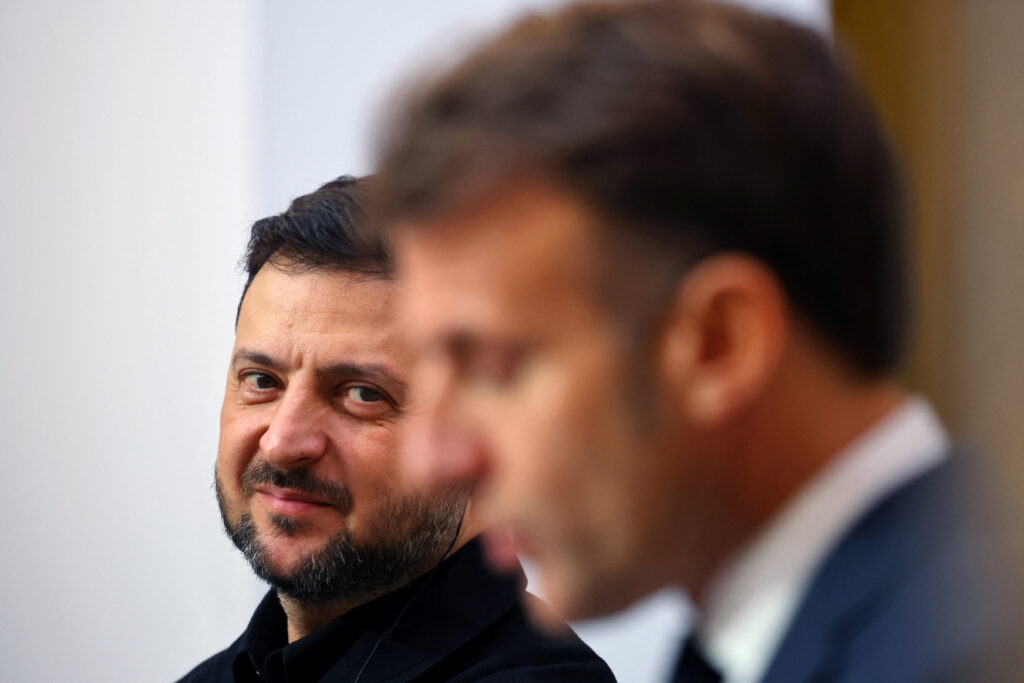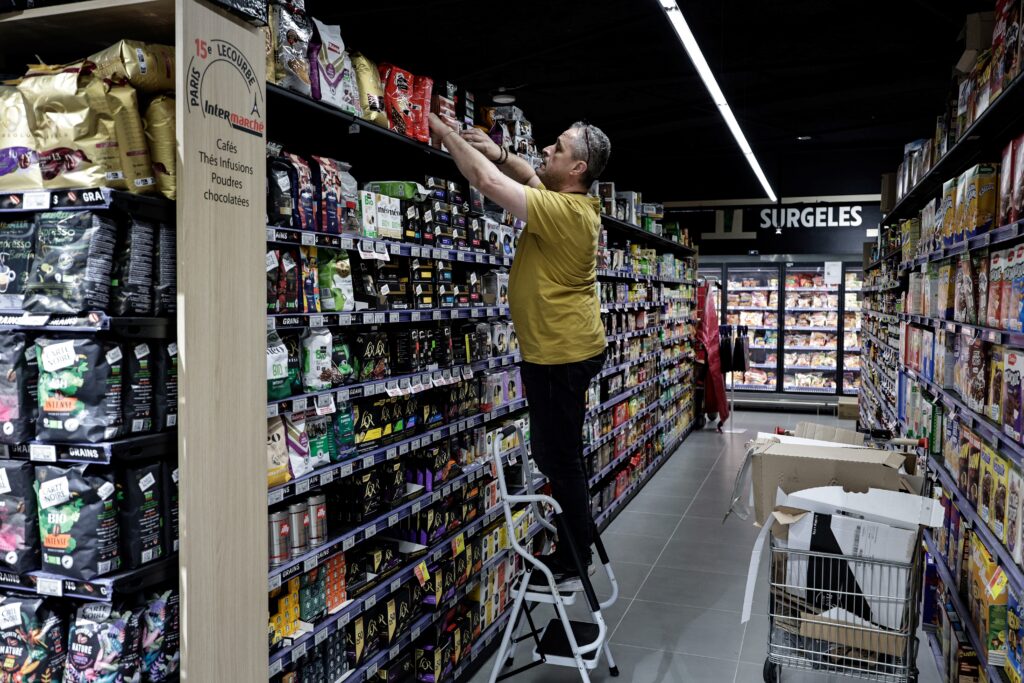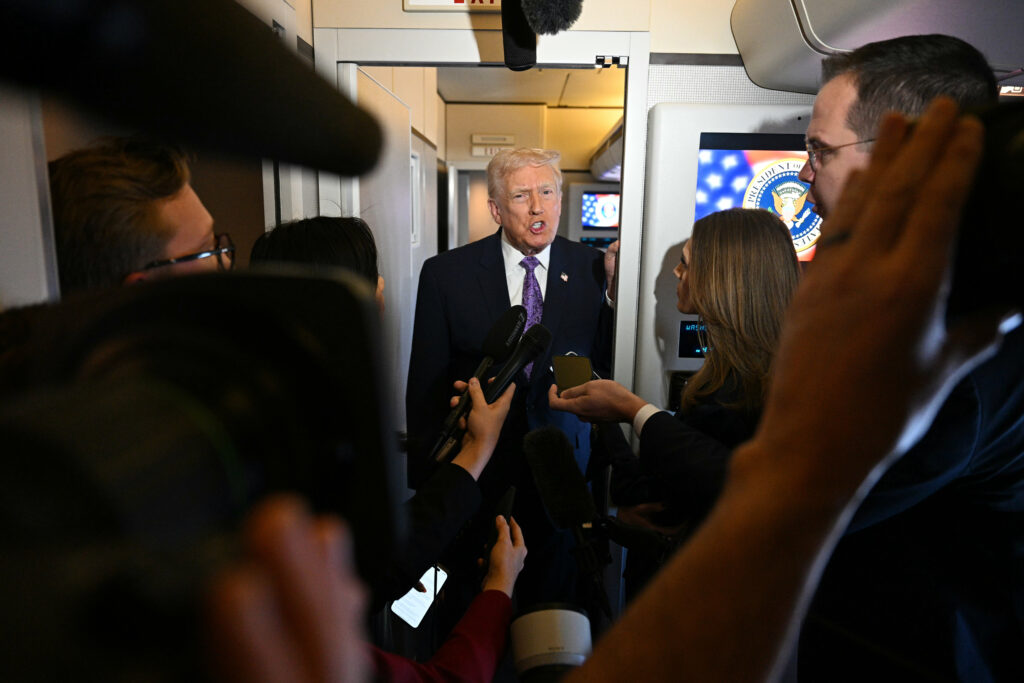Négociations sur l’Ukraine: Zelensky reçu par Macron, Trump fait part de son optimisme
Le président français Emmanuel Macron reçoit lundi à Paris son homologue ukrainien Volodymyr Zelensky qui est sous fortes pressions militaire et politique, au moment où Donald Trump a fait part de son optimisme sur un règlement du conflit avec la Russie.Alors que Kiev est confrontée à une progression militaire de Moscou dans l’est du pays et qu’elle est secouée par un grave scandale de corruption, des délégations ukrainienne et américaine ont négocié plusieurs heures dimanche en Floride. Elles ont qualifié leurs pourparlers de “productifs”.M. Zelensky sera reçu à l’Elysée à 10H00 (09H00 GMT) et les deux chefs d’Etat feront une déclaration à la presse avant un entretien et un déjeuner de travail.”Les deux dirigeants échangeront sur la situation et sur les conditions d’une paix juste et durable, dans la continuité des discussions de Genève et du plan américain et d’une concertation étroite avec nos partenaires européens”, a indiqué la présidence française.Les Etats-Unis ont présenté il y a dix jours un projet en 28 points, rédigé sans les alliés européens de Kiev, censé mettre fin au conflit déclenché par l’offensive russe contre l’Ukraine en février 2022.Le document, jugé très favorable à Moscou, prévoyait que les forces ukrainiennes se retirent de la région orientale de Donetsk, et les États-Unis auraient alors reconnu de facto la région de Donetsk, la Crimée et la région de Lougansk comme russes.Mais il a été amendé à l’issue de réunions à Genève, à la demande des Européens, même si son contenu reste flou.- “Productives” mais “pas faciles” -Les discussions américano-ukrainiennes en Floride ont été jugées “productives” par les deux parties, mais le secrétaire d’Etat Marco Rubio a prévenu qu'”il restait encore du travail” et une source ukrainienne les a qualifiées de “pas faciles”. Le président Donald Trump a, lui, affiché son optimisme.”Je pense que la Russie aimerait que cela se termine, et je pense que l’Ukraine, je sais que l’Ukraine aimerait que cela se termine”, a-t-il lancé à bord de l’Air Force One.Le milliardaire républicain a rappelé que Kiev n’était pas en position de force, pointant le vaste scandale de corruption qui a conduit M. Zelensky à limoger son très influent bras droit, Andriï Iermak. “L’Ukraine a quelques petits problèmes difficiles”, a critiqué M. Trump. “Il y a une situation de corruption, ce qui n’aide pas”.- Witkoff à Moscou -Le président des Etats-Unis dépêche une nouvelle fois à Moscou son émissaire spécial Steve Witkoff, accusé d’être très proche des Russes et qui doit revoir mardi le président Vladimir Poutine.”Ce sont des jours importants”, a écrit sur X Volodymyr Zelensky, qui s’est entretenu également avec le secrétaire général de l’Otan Mark Rutte et la présidente de la Commission européenne Ursula von der Leyen.”Il est important que les discussions aient une dynamique constructive et que toutes les questions aient été abordées ouvertement et avec un objectif clair de garantir la souveraineté et les intérêts nationaux de l’Ukraine,” a-t-il ajouté à l’issue des négociations en Floride.Le meneur ukrainien de ces discussions, Rustem Oumerov, a fait part de “progrès substantiels”.Sur le terrain, Moscou exerce une pression militaire sur Kiev: son armée progresse dans l’est de l’Ukraine et une nouvelle attaque de drones dans la nuit de samedi à dimanche a fait un mort et 11 blessés en banlieue de Kiev.Quelques heures plus tôt, l’Ukraine avait revendiqué l’attaque avec des drones navals de deux pétroliers de la flotte fantôme russe en mer Noire. Et ces mêmes engins avaient été lancés contre un terminal pétrolier dans le port russe de Novorossiïsk.Pour Paris, le président Zelensky “dispose de toute la légitimité pour conduire l’Ukraine vers la paix”, selon le ministre des Affaires étrangères français Jean-Noël Barrot, dans le journal La Tribune Dimanche.En France, M. Zelensky doit être accompagné par son épouse Olena Zelenska pour un événement autour de l’initiative “Bring kids back” (“Ramenez les enfants”)dont elle est la marraine.Cette initiative “a permis de ramener près de 2.000 enfants ukrainiens arrachés à leur famille par la Russie”, a souligné M. Barrot, qui rappelle que “ce crime de guerre odieux vaut à Vladimir Poutine son mandat d’arrêt de la Cour pénale internationale”.Le chef de la diplomatie française et sa collègue de la Culture, Rachida Dati, doivent aussi lancer la “saison de l’Ukraine en France”, en présence du ministre ukrainien des Affaires étrangères, Andrii Sybiha: des événements sont prévus dans plusieurs villes françaises jusqu’en mars.
Coup d’envoi apaisé des négociations entre industriels et supermarchés
Pâtes, poulet et calumet de la paix: source d’habituelles tensions sur fond de guerre des prix, les négociations commerciales annuelles entre la grande distribution et l’industrie agroalimentaire démarrent lundi dans un contexte apaisé après la signature d’une charte censée ramener le calme autour de la table.D’ici au 1er mars, trois mois de négociations intenses fixeront les prix et les conditions (modalités de livraison, calendrier promotionnel…) auxquelles les grandes surfaces s’approvisionnent auprès des fabricants. Ces tractations opposent des distributeurs en quête de prix compétitifs pour attirer les clients, et des industriels invoquant coûts de production et besoins d’investissements. Opaques et sources de tensions, elles sont accusées de tirer vers le bas les revenus des agriculteurs malgré leur encadrement par la loi Egalim.Elles déterminent in fine les tarifs en rayon, uniquement pour les produits de grandes marques (par exemple Nutella de Ferrero, Actimel de Danone, bonbons Haribo…), et non ceux des marques des supermarchés (Carrefour, Marque Repère, U…), qui pèsent plus du tiers des ventes.Mais cette année, les discussions ont commencé avant l’heure, début novembre, pour élaborer une charte commune inédite engageant toutes les parties prenantes, la Fédération du commerce et de la distribution (FCD) et cinq organisations d’industriels (Ania, Ilec, Feef, Pact’Alim, et la Coopération agricole).- Des PME mieux considérées -Au terme d’un dialogue “constructif”, aux dires de plusieurs participants, la fumée blanche est sortie dimanche, avec la signature d’un document construit autour de trois thèmes: le respect mutuel lors des échanges, une attention particulière portée aux PME et la valorisation des produits frais et de l’origine des produits.”C’est un signal positif après des années d’hyperinflation. N’oublions pas que l’enjeu de ces négociations est le tarif payé par le consommateur”, a commenté sur LinkedIn Thierry Cotillard, patron du Groupement Mousquetaires/Intermarché.Cette charte “constitue une avancée vers des négociations commerciales plus apaisées et de bonne foi”, s’est félicitée Karima Kaci, directrice générale de Pact’Alim, qui représente 3.000 PME et entreprises de taille intermédiaire (ETI) de l’industrie alimentaire.Le traitement différencié pour les PME, dont les négociations avec la grande distribution devront être bouclées avant le 15 janvier, a été particulièrement salué par les participants.”Ça veut dire des négociations plus rapides, plus courtes et ça permet de se concentrer sur le développement de l’activité, sur les investissements, sur le développement de produits”, résume auprès de l’AFP Léonard Prunier, de la Feef, qui représente 22.000 PME et ETI.- “Volonté collective” -Mais ce document, non contraignant, résistera-t-il à la guerre des prix? Dominique Schelcher, le patron de Coopérative U, a dit redouter “des exigences très fortes des multinationales” face aux “postures beaucoup plus raisonnables des PME”, comme ce fut le cas dernièrement, selon lui, pour la négociation sur les chocolats de Pâques 2026.”L’enjeu principal pour les PME et ETI sera que la hausse des tarifs ne puisse être inférieure à la hausse de la matière première agricole. Il en va de notre souveraineté alimentaire”, prévient Karima Kaci.Le lancement prochain, par le Sénat, d’une commission d’enquête sur les marges de la grande distribution, à l’initiative des Ecologistes, pourraient aussi parasiter le processus.En 2025, les industriels de l’agroalimentaire ont obtenu 1,5% de hausse moyenne des prix alors qu’ils demandaient une augmentation moyenne de 5,7%.”Ce n’est pas juste un acte politique, c’est une volonté collective de progresser”, assure Judith Jiguet, déléguée générale de la Fédération du commerce et de la distribution (FCD). “On va se donner des clauses de revoyure tout au long de ces trois mois à venir et on fera un bilan ensemble.””Pas de géant”, selon ses mots, ou simple vœu pieu? Le climat des prochains jours apportera de premières réponses.
Asian markets mixed as traders eye US data ahead of Fed decision
Asian equities were mixed Monday with investors awaiting the release of key US data that could play a role in Federal Reserve deliberations ahead of an expected interest rate cut next week.After November’s end-of-month rebound across world markets, confidence remains high amid speculation the US central bank could continue easing monetary policy into the new year.That has helped overcome lingering worries about an AI-fuelled tech bubble that some observers warn could pop and lead to a painful correction.While the odds on a third successive rate reduction on December 10 are hovering around 90 percent, traders will keep a close eye on this week’s batch of indicators to gauge the Fed’s desire to keep on cutting.Among the reports due for release are private jobs creation, services activity and personal consumption expenditure — the Fed’s preferred gauge of inflation.Bets on a cut surged in late November after several of the bank’s policymakers said they backed lower borrowing costs as they were more concerned about the flagging labour market than stubbornly high inflation.That helped markets recover the losses sustained in the first half of the month, and analysts said they could be in store for an end-of-year rally.”As the clouds of worry that cast an ominous shadow over markets through to mid-November gently dissipate, they give way to new emotions — notably the fear of not participating and the risk of underperforming benchmark targets,” said Pepperstone’s Chris Weston.However, he warned that “risk managers remain highly astute to the landmines that could still derail the improving risk backdrop through December”.He cited the possibility the Fed does not cut, or offers a “hawkish cut”, the Supreme Court’s possible decision on the legality of President Donald Trump’s trade tariffs, and jobs and inflation data.Meanwhile, reports that Trump’s top economic adviser Kevin Hassett — a proponent of rate cuts — is the frontrunner to take the helm at the Fed next year added to the upbeat mood.After last week’s healthy gains and Wall Street’s strong Thanksgiving rally, Asian equities were mixed.Hong Kong, Shanghai, Singapore and Manila rose, but Sydney, Seoul, Wellington and Taipei dipped.Tokyo sank more than one percent as the yen strengthened on expectations the Bank of Japan will lift interest rates this month.Governor Kazuo Ueda said it would “consider the pros and cons of raising the policy interest rate and make decisions as appropriate”, with Bloomberg saying traders saw a more than 60 percent chance of a move on December 19. That rose to 90 percent for a hike no later than January.Oil prices surged more than one percent after OPEC+ confirmed it would not hike output in the first three months of 2026.Oil jumped after OPEC+ confirmed it will stick with plans to pause production hikes during the first quarter, citing lower seasonal demand.The decision comes amid uncertainty over the outlook for crude as traders look for indications of progress in Ukraine peace talks, which could lead to the return of Russian crude to markets.- Key figures at around 0230 GMT -Tokyo – Nikkei 225: DOWN 1.7 percent at 49,407.31 (break) Hong Kong – Hang Seng Index: UP 0.6 percent at 26,012.78Shanghai – Composite: UP 0.2 percent at 3,896.72Euro/dollar: DOWN at $1.1597 from $1.1604 on FridayPound/dollar: DOWN at $1.3230 from $1.3245Dollar/yen: DOWN at 155.60 yen from 156.10 yenEuro/pound: UP at 87.67 pence from 87.60 penceWest Texas Intermediate: UP 1.5 percent at $59.41 per barrelBrent North Sea Crude: UP 1.4 percent at $63.25 per barrelNew York – Dow: UP 0.6 percent at 47,716.42 (close)London – FTSE 100: UP 0.3 percent at 9,720.51 (close)
Trump optimiste sur un accord Ukraine-Russie, son chef de la diplomatie reste prudent
Donald Trump a estimé dimanche qu’il y avait “de bonnes chances” pour un accord mettant fin au conflit entre la Russie et l’Ukraine, après des pourparlers entre Washington et Kiev, à l’issue desquels son chef de la diplomatie Marco Rubio est resté bien plus prudent.Qualifiées de “productives” par les deux délégations américaine et ukrainienne, ces …
Trump optimiste sur un accord Ukraine-Russie, son chef de la diplomatie reste prudent Read More »
Four dead, including three children, in California party shooting
Four people including three children were killed and 11 more were wounded in a shooting at a birthday party in California, authorities said Sunday, calling it a targeted attack that may have involved multiple gunmen.The shooting took place Saturday evening inside a banquet hall in Stockton, a city northeast of San Francisco, where between 100 and 150 people had gathered for the celebration.The four victims were aged eight, nine, 14 and 21, San Joaquin County Sheriff Patrick Withrow told reporters on Sunday. At least one of the 11 wounded was in critical condition, he said, adding he did not have more information about the others.”We believe, from what we’ve gathered so far, that it appears to be multiple shooters,” Withrow said.He called on the public to remain cautious as the investigation unfolds.Earlier, his spokeswoman Heather Brent said it appeared to have been a “targeted” shooting.The sheriff’s office urged anyone with information or video footage to come forward. So far, no one has been taken into custody.”These animals walked in and shot children at a children’s birthday party, and none of us should stand for that,” Withrow said. “And so if you know anything about this, you have to come forward and tell us what you know.”- $25,000 reward -Stockton Mayor Christina Fugazi said a $25,000 reward would be given to anyone providing information that led to the arrest of the assailants.While the sheriff said he could not yet confirm if the incident was gang-related, Fugazi did not hold back about who she believed to be responsible.”Let us call this what it is. Gang violence exists in cities across the country, but this act was a pure act of terrorism,” she said in a post on Facebook.Withrow said firearms were found on the roof of the building where the shooting occurred, but it was not clear if they were related to the crime. California Governor Gavin Newsom was briefed on the shooting, his office said on social media.There have been 504 mass shootings in the United States so far this year including the Stockton incident, according to the Gun Violence Archive, which defines a mass shooting as four or more people shot.burs-nr-rfo/sst/jgc





